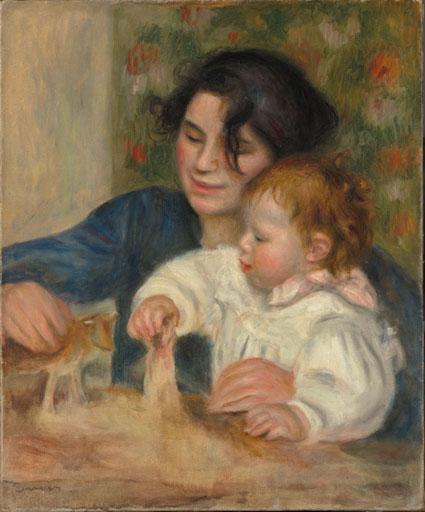I recently had the pleasure of interviewing LACMA curator Claudia Einecke about the exhibition Renoir in the 20th Century, which opens on Sunday. Claudia spoke about how art historians have tended to overlook Renoir’s late paintings, and her opinion that it is high time we reexamine this body of work.
Q. The show includes numerous paintings of Renoir’s immediate family, especially his son Jean and his nanny, Gabrielle. Tell me about them.
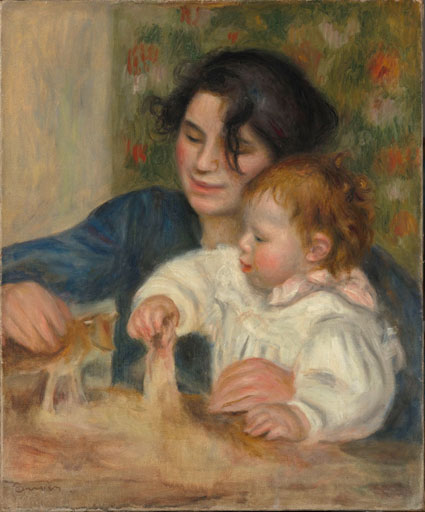
Pierre-Auguste Renoir, "Gabrielle and Jean," 1895, Musée de l'Orangerie, Paris, Jean Walter and Paul Guillaume Collection, photo © 2009 Musée de l'Orangerie, Paris/RMN, by Hervé Lewandowski
A. The picture of Jean and his nanny, Gabrielle (a cousin of Renoir’s wife), is one of those images that look very naturalistic and very caught on the fly. The young boy is doing a normal everyday activity. At the same time the picture itself contains associations and references to Old Master art. In this, as in most of Renoir’s paintings, you see him combine realism and informality with references to high art—art with a capital “A” if you wish.
When Pablo Picasso became a father, he started drawing and painting his young children similarly absorbed in activity. Even though Picasso’s pictures will never look like Renoir’s, I believe the way of approaching the subject matter and the composition is something that Picasso got from looking at Renoir’s pictures.
Q. The show includes sculpture by Maillol. What is the connection between the two artists?
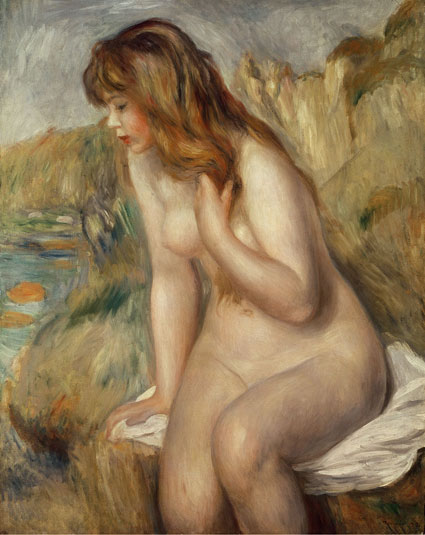
Pierre-Auguste Renoir, "Bather on a Rock," 1892, private collection, Paris, photo © 2009 Private Collection/Peter Willi/The Bridgeman Art Library
A. Maillol, who is now mostly known as a sculptor, began his career as a painter and was greatly influenced by Renoir and Renoir’s nudes. He said to a sculptor colleague, “Look at Renoir’s nudes. They are sculpture. That’s all you need.”
This seated bather is probably the type of nude that inspired Maillol, in the way the figure occupies the space fully and is fully rounded. The background is really just a backdrop against which the figure emerges as a fully three-dimensional entity. I think the monumentality—the fullness of Renoir’s figures—is something that we find very much reflected in Maillol. They share a similar preference for a powerful physical type.
Q. Late in his life, Renoir lived in the South of France. What was significant about his move there?
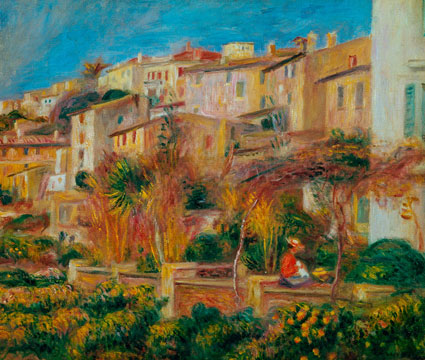
Pierre-Auguste Renoir, "Terrace at Cagnes," 1905, Bridgestone Museum of Art, Ishibashi Foundation, Tokyo, photo © 2009 Bridgestone Museum of Art, Ishibashi Foundation, all rights reserved
A. Terrace at Cagnes shows the village where the family first lived when they moved to the south. You can actually see the location of Renoir’s apartment: it’s the white building on the extreme right.
Initially, Renoir moved to the south of France for health reasons (he suffered from crippling rheumatoid arthritis). But I think he also had a very special understanding and appreciation of the landscape in that region. He understood the south of France as the site where the old Arcadian myth originated—the kind of landscape where you can imagine nymphs and gods and goddesses living as they do in Greek mythology.
Q. The painting of Jean Renoir dressed as a hunter belongs to the museum, and it is a favorite of many visitors to LACMA. Tell me about it.
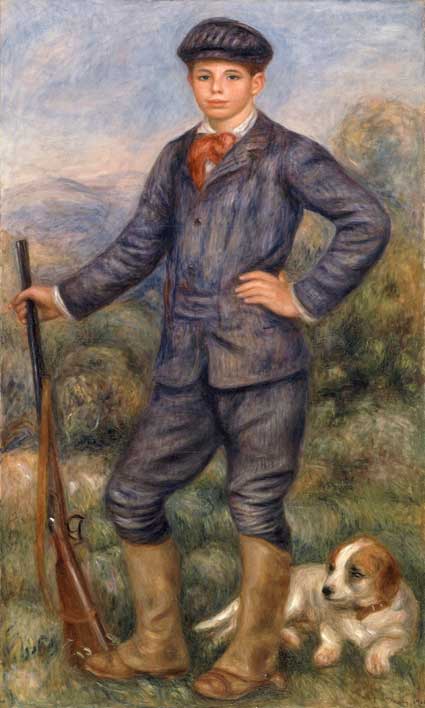
Pierre-Auguste Renoir, "Jean as a Huntsman," 1910, Los Angeles County Museum of Art, gift through the generosity of the late Mr. Jean Renoir and Madame Dido Renoir, photo © 2009 Museum Associates/LACMA
A. Jean Renoir became quite a well-known film director and eventually moved to Los Angeles. Years after the painting was made, he recalled posing for the picture. He wrote, “At Les Collettes, when I was fifteen years old, I wore a jacket that reminded my father of a hunter, so he had me pose with a gun and with Bob for a hunting dog. The gun was borrowed from one of our farmers. I shot it only once, killed a bird, and was horrified.”
Jean spoke at LACMA in 1979, and at that time, he recalled that his father intended the painting to fit a specific frame—a magnificent carved and gilded antique Italian frame. The painting is still displayed in that frame today.
Q. How do you hope Renoir will be remembered?
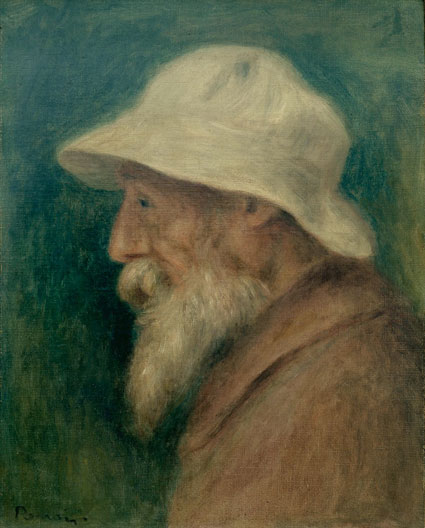
Pierre-Auguste Renoir, "Self-Portrait with White Hat," 1910, private collection courtesy of Galerie Durand-Ruel, Paris, photo courtesy Galerie Durand-Ruel, Paris/akg-images
A. Renoir is usually seen and thought of as an impressionist and he’s been appreciated as an impressionist, but in fact, he left impressionism behind around 1880. His later paintings really took a different turn. His late paintings reveal his knowledge of old masters like Titian and Reubens.
In the twentieth century, art historians tended to favor modern art that led directly to modern twentieth century abstract painting. Many critics felt that Renoir’s late painting was old-fashioned, reactionary, and not modern. I think it is time that the great prolific work that he did later in his career be recognized and understood on its own terms, as something that is going someplace—perhaps just not where modernist critics wanted it to go.
In particular, one of the aspects of his work that has created a lot of discomfort among critics and art historians are his late nudes. I hope that today, with developments in contemporary art, where you have artists distorting the body as well, maybe we are ready to look at these works and judge them on different terms.



